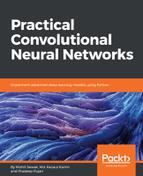The convolutional layer helps to detect regional patterns in an image. The max pooling layer, present after the convolutional layer, helps reduce dimensionality. Here is an example of image classification using all the principles we studied in the previous sections. One important notion is to first make all the images into a standard size before doing anything else. The first convolution layer requires an additional input.shape() parameter. In this section, we will train a CNN to classify images from the CIFAR-10 database. CIFAR-10 is a dataset of 60,000 color images of 32 x 32 size. These images are labeled into 10 categories with 6,000 images each. These categories are airplane, automobile, bird, cat, dog, deer, frog, horse, ship, and truck. Let's see how to do this with the following code:
import keras
import numpy as np
import matplotlib.pyplot as plt
%matplotlib inline
fig = plt.figure(figsize=(20,5))
for i in range(36):
ax = fig.add_subplot(3, 12, i + 1, xticks=[], yticks=[])
ax.imshow(np.squeeze(x_train[i]))from keras.datasets import cifar10
# rescale [0,255] --> [0,1]
x_train = x_train.astype('float32')/255
from keras.utils import np_utils
# one-hot encode the labels
num_classes = len(np.unique(y_train))
y_train = keras.utils.to_categorical(y_train, num_classes)
y_test = keras.utils.to_categorical(y_test, num_classes)
# break training set into training and validation sets
(x_train, x_valid) = x_train[5000:], x_train[:5000]
(y_train, y_valid) = y_train[5000:], y_train[:5000]
# print shape of training set
print('x_train shape:', x_train.shape)
# printing number of training, validation, and test images
print(x_train.shape[0], 'train samples')
print(x_test.shape[0], 'test samples')
print(x_valid.shape[0], 'validation samples')x_test = x_test.astype('float32')/255
from keras.models import Sequential
from keras.layers import Conv2D, MaxPooling2D, Flatten, Dense, Dropout
model = Sequential()
model.add(Conv2D(filters=16, kernel_size=2, padding='same', activation='relu',
input_shape=(32, 32, 3)))
model.add(MaxPooling2D(pool_size=2))
model.add(Conv2D(filters=32, kernel_size=2, padding='same', activation='relu'))
model.add(MaxPooling2D(pool_size=2))
model.add(Conv2D(filters=64, kernel_size=2, padding='same', activation='relu'))
model.add(MaxPooling2D(pool_size=2))
model.add(Conv2D(filters=32, kernel_size=2, padding='same', activation='relu'))
model.add(MaxPooling2D(pool_size=2))
model.add(Dropout(0.3))
model.add(Flatten())
model.add(Dense(500, activation='relu'))
model.add(Dropout(0.4))
model.add(Dense(10, activation='softmax'))
model.summary()
# compile the model
model.compile(loss='categorical_crossentropy', optimizer='rmsprop',
metrics=['accuracy'])
from keras.callbacks import ModelCheckpoint
# train the model
checkpointer = ModelCheckpoint(filepath='model.weights.best.hdf5', verbose=1,
save_best_only=True)
hist = model.fit(x_train, y_train, batch_size=32, epochs=100,
validation_data=(x_valid, y_valid), callbacks=[checkpointer],
verbose=2, shuffle=True)
